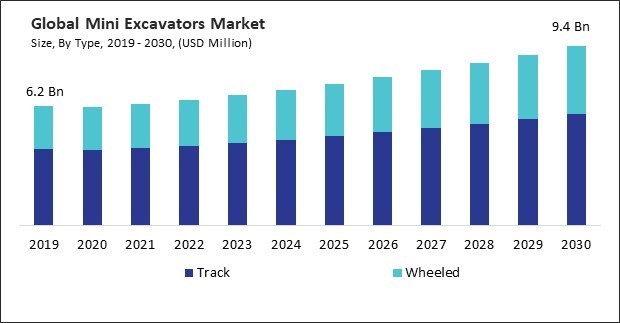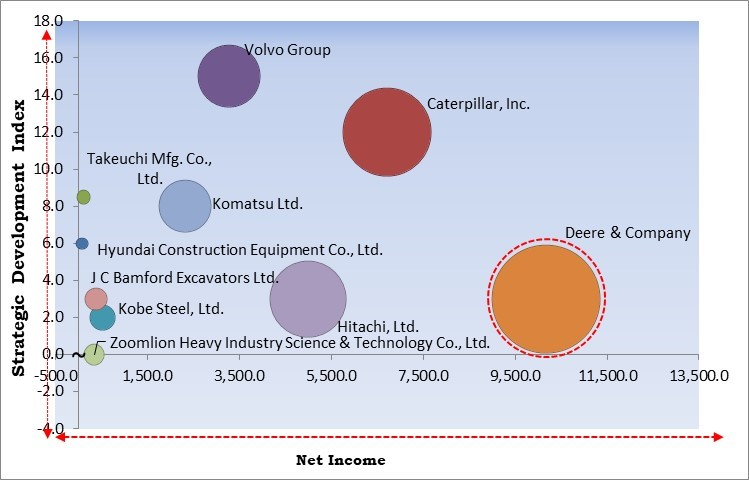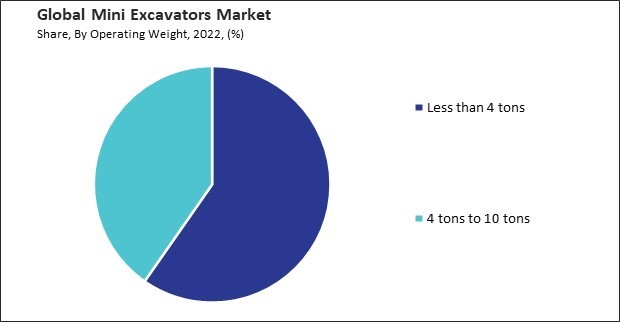“Global Mini Excavators Market to reach a market value of USD 9.4 Billion by 2030 growing at a CAGR of 4.7%”
The Global Mini Excavators Market size is expected to reach $9.4 billion by 2030, rising at a market growth of 4.7% CAGR during the forecast period.
Government initiatives and investments in infrastructure projects, such as road construction, bridge building, and utility upgrades, have also contributed to the increasing usage of mini excavators in North America. Therefore, the North America region captured $1,947.7 million revenue in the market in 2022. These machines are essential for these projects due to their versatility and ability to work in various conditions. As a result, the requirement for these is accelerating. This factor is augmenting the growth of the regional market.

The major strategies followed by the market participants are Product Launches as the key developmental strategy to keep pace with the changing demands of end users. For instance, In December, 2023, Caterpillar, Inc. introduced CAT 306 CR next generation mini hydraulic excavator. The excavator incorporates heavy-duty main structures along with load-sensing hydraulics and a Cat Stick Steer system. Additionally, it has a maximum dig depth of 4 110 mm (162 in). Additionally, In September, 2023, Hyundai Construction Equipment North America released three new models in the HX-A series of compact hydraulic excavators at the Utility Expo. The HX35AZ has a 24.8 hp Kubota engine, while the HX40A and HX48AZ feature 37.4 hp Yanmar engines, all Tier 4 Final compliant.
Based on the Analysis presented in the KBV Cardinal matrix; Deere & Company is the forerunner in the market. In January 2023, John Deere announced its venture into construction equipment electrification with the launch of its electric excavator at leading tech event, CES 2023. The machine is powered by a battery made by Kreisel Electric. Additionally, the company says, the new electric excavator is expected to lower daily operating costs, reduce jobsite noise and enhance machine reliability, all while producing zero emissions and the same power and performance operators need in a machine. Companies such as Volvo Group, Caterpillar, Inc., Hitachi, Ltd. are some of the key innovators in the market.

The global trend of rapid urbanization has led to increased demand for construction equipment, including mini excavators, to support the construction of buildings, roads, bridges, and other infrastructure projects in urban areas. As a result of globalization, emerging economies, such as India, Brazil, Mexico, and China, have witnessed rapid industrial expansion. Various sectors like food and beverage, retail, healthcare, and automotive are focusing on developing in emerging economies due to various economic advantages. The rising demand for these items is putting strain on their supply chain and logistics systems. As a result, demand for automated warehouses is increasing across industries, increasing demand for excavators. As a result, these factors are anticipated to offer new growth opportunities for market players in the market in the coming years.
Technological advancements in these have revolutionized the capabilities and efficiency of these machines, enhancing their performance across a wide range of applications. Modern mini excavators are equipped with advanced hydraulic systems that offer improved precision and control. These systems provide smoother operation and more efficient power delivery, allowing operators to perform tasks more accurately and quickly. Advanced hydraulic systems also contribute to their overall durability and reliability. Moreover, manufacturers have made significant strides in improving the fuel efficiency of mini excavators. This has been achieved through advanced engine technologies, such as electronic fuel injection and variable displacement pumps, which optimize fuel consumption without compromising performance. Consequently, these advancements continue to drive innovation in the market, leading to further improvements in performance, reliability, and overall value for operators and businesses alike.
The high upfront investment required to purchase a mini excavator can be a major barrier for businesses, especially smaller enterprises with limited capital. This can limit their ability to invest in new equipment, leading to reduced demand in certain market segments. Additionally, the preference for rental options over purchasing can be driven by these high initial costs, further dampening the demand for new mini excavators as businesses opt for more flexible short-term arrangements. Moreover, the total cost of ownership for a mini excavator, which includes the initial purchase price and operating and maintenance costs over its lifespan, can be substantial. As a result, the financial risk associated with owning and operating a mini excavator can be perceived as too high for some businesses, further impacting the demand for these machines.
On the basis of type, the market is bifurcated into wheeled and track. In 2022, the track segment acquired the largest revenue share in the market. Tracked mini excavators are equipped with tracks instead of wheels, providing superior traction and stability, especially in challenging terrain conditions such as soft soils, mud, or uneven surfaces. This enhanced traction allows tracked mini excavators to operate more effectively in off-road environments and on slopes where wheeled machines may struggle. These excavators are majorly found in construction projects where there are loads of waste. Due to this function, the demand for tracked mini excavators is increasing, in turn propelling the growth of the segment.
Based on the operating weight, the market is divided into less than 4 tons and 4 tons to 10 tons. In 2022, the 4 tons to 10 tons segment recorded a substantial revenue share in the market. The growth of the segment is attributed to the robust build of these machines. Mini excavators in the 4 to 10 tons operating weight range offer higher horsepower, digging force, and lifting capacity compared to smaller machines. This increased power and performance make them suitable for more demanding tasks such as digging trenches, excavating foundations, and lifting heavier loads.

By end-user, the market is segregated into landscaping & construction and agriculture. In 2022, the landscaping and construction segment witnessed the largest revenue share in the market. The growing demand for landscaping services in residential and commercial sectors has increased demand for mini excavators. These machines are essential for land clearing, grading, and creating landscape features. Excavators are frequently used to clear land for projects like retaining walls or excavating to build attractive water features, even in the narrowest places.
Free Valuable Insights: Global Mini Excavators Market size to reach USD 9.4 Billion by 2030
Region-wise, the market is analyzed across North America, Europe, Asia Pacific, and LAMEA. In 2022, the Asia Pacific region accounted for the highest revenue share in the market. Many countries in the Asia-Pacific region are undergoing rapid urbanization and infrastructure development. This has led to an increased demand for construction machinery, including mini excavators, to support building roads, bridges, buildings, and other infrastructure projects in urban and rural areas. These factors are expected to continue to drive the demand for these in the region in the coming years.
| Report Attribute | Details |
|---|---|
| Market size value in 2022 | USD 6.5 Billion |
| Market size forecast in 2030 | USD 9.4 Billion |
| Base Year | 2022 |
| Historical Period | 2019 to 2021 |
| Forecast Period | 2023 to 2030 |
| Revenue Growth Rate | CAGR of 4.7% from 2023 to 2030 |
| Number of Pages | 229 |
| Number of Tables | 323 |
| Report coverage | Market Trends, Revenue Estimation and Forecast, Segmentation Analysis, Regional and Country Breakdown, Competitive Landscape, Porter’s 5 Forces Analysis, Company Profiling, Companies Strategic Developments, SWOT Analysis, Winning Imperatives |
| Segments covered | Type, Operating Weight, End User, Region |
| Country scope |
|
| Companies Included | Volvo Group, Kobe Steel, Ltd., Hyundai Construction Equipment Co., Ltd., Caterpillar, Inc., Komatsu Ltd., Deere & Company, Hitachi, Ltd., J C Bamford Excavators Ltd., Takeuchi Mfg. Co., Ltd., Zoomlion Heavy Industry Science & Technology Co., Ltd. |
By Type
By Operating Weight
By End User
By Geography
This Market size is expected to reach $9.4 billion by 2030.
Rapid urbanization and infrastructure development are driving the Market in coming years, however, Competition from the rental market restraints the growth of the Market.
Volvo Group, Kobe Steel, Ltd., Hyundai Construction Equipment Co., Ltd., Caterpillar, Inc., Komatsu Ltd., Deere & Company, Hitachi, Ltd., J C Bamford Excavators Ltd., Takeuchi Mfg. Co., Ltd., Zoomlion Heavy Industry Science & Technology Co., Ltd.
The expected CAGR of this Market is 4.7% from 2023 to 2030.
The Less than 4 tons segment is generating highest revenue in the Market, By Operating Weight in 2022; thereby, achieving a market value of $5.4 billion by 2030.
The Asia Pacific region dominated the Market, By Region in 2022, and would continue to be a dominant market till 2030; thereby, achieving a market value of $3.7 billion by 2030.
Our team of dedicated experts can provide you with attractive expansion opportunities for your business.

 Drivers
Drivers
 Restraints
Restraints
